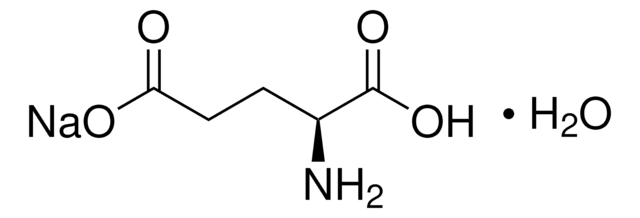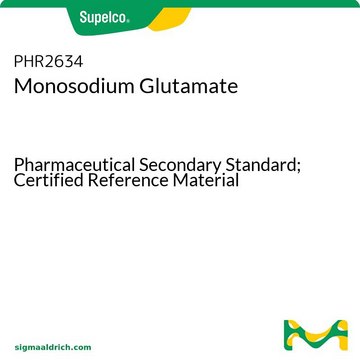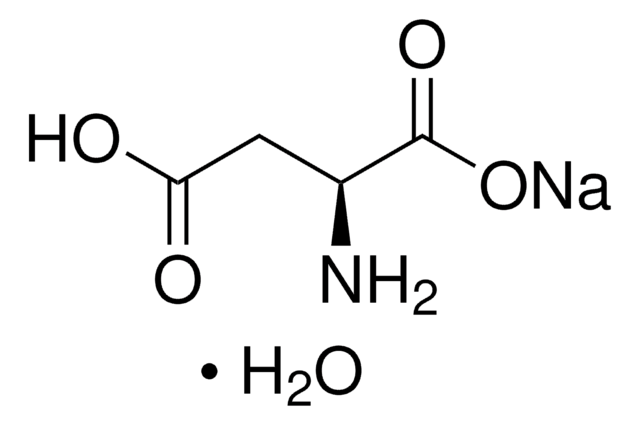G1626
L-Glutamic acid monosodium salt hydrate
≥99% (HPLC), powder
Sinónimos:
(S)-2-Aminopentanedioic acid, L-Glutamic acid monosodium salt, Glu, MSG, Monosodium glutamate
About This Item
Productos recomendados
assay
≥99% (HPLC)
form
powder
color
white to off-white
InChI
1S/C5H9NO4.Na.H2O.H/c6-3(5(9)10)1-2-4(7)8;;;/h3H,1-2,6H2,(H,7,8)(H,9,10);;1H2;
InChI key
JYDGDQPVBSBYRT-UHFFFAOYSA-N
Gene Information
human ... GRIK1(2897) , GRIK2(2898) , GRIK3(2899) , GRIK4(2900) , GRIN1(2902) , GRIN2A(2903) , GRIN2B(2904) , GRIN2C(2905) , GRIN2D(2906) , GRIN3A(116443) , GRIN3B(116444) , GRINA(2907)
mouse ... GRIK1(14805) , GRIK2(14806) , GRIK3(14807) , GRIK4(110637) , GRIN1(14810) , GRIN2A(14811) , GRIN2B(14812) , GRIN2C(14813) , GRIN2D(14814) , GRIN3A(242443) , GRIN3B(170483) , GRINA(66168)
rat ... GRIK1(29559) , GRIK2(54257) , GRIK3(298521) , GRIK4(24406) , GRIN1(24408) , GRIN2A(24409) , GRIN2B(24410) , GRIN2C(24411) , GRIN2D(24412) , GRIN3A(191573) , GRIN3B(170796) , GRINA(266668)
¿Está buscando productos similares? Visita Guía de comparación de productos
General description
Application
- as a chemical modulator to rat hippocampal slice cultures for the study of microglial movement post spreading depression (SD) prior to migraine
- as an additive to Neurobasal medium for the growth of embryonic neurons obtained from pregnant mice
- as a component of GYE (glucose yeast extract) solid medium for the growth of four strains of phytopathogen Xylella fastidiosa namely, CVC clone 9a5c, Temecula (Pierce′s disease), Jab1 (Coffee Leaf Scorch), and the isolate 6747 (Plum Leaf Scald), which causes diseases in important crop plants
- as a component of the stock solution for the equilibration of intracellular and extracellular [H+] in segmental nerves obtained from the ventral ganglion of Drosophila larvae
- as a supplement to RPMI (Roswell Park Memorial Institute) medium 1640 used to maintain K562 cell cultures with twice-weekly passage
Biochem/physiol Actions
Storage Class
11 - Combustible Solids
wgk_germany
WGK 2
flash_point_f
Not applicable
flash_point_c
Not applicable
ppe
Eyeshields, Gloves, type N95 (US)
Certificados de análisis (COA)
Busque Certificados de análisis (COA) introduciendo el número de lote del producto. Los números de lote se encuentran en la etiqueta del producto después de las palabras «Lot» o «Batch»
¿Ya tiene este producto?
Encuentre la documentación para los productos que ha comprado recientemente en la Biblioteca de documentos.
Los clientes también vieron
Nuestro equipo de científicos tiene experiencia en todas las áreas de investigación: Ciencias de la vida, Ciencia de los materiales, Síntesis química, Cromatografía, Analítica y muchas otras.
Póngase en contacto con el Servicio técnico







